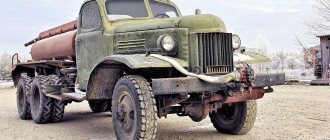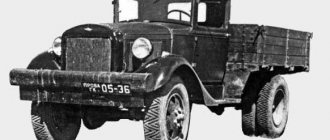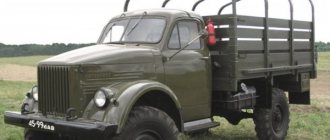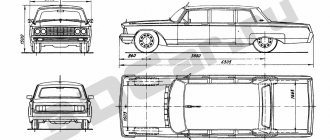With the beginning of the Great Patriotic War, the Red Army was faced with a shortage, or rather, the almost complete absence of light army vehicles with all-wheel drive. The GAZ-61s available in scanty quantities could not do the weather. At the end of the summer of 1941, mass production of the GAZ-64, made in the image of the American Bantam BRC40, began.
Intensive military use of the vehicle revealed the weak points of the SUV, in particular, the narrow track and low strength of the frame elements. As a result of the modernization carried out in 1943, the GAZ-67 car appeared, which lasted on the assembly line for 10 years.
Description
So what kind of car is this? GAZ-67 is an all-wheel drive SUV with a simplified body. It involves no roof, a folding windshield and no doors. Instead of the latter there were only cutouts. The vehicle also featured a unique bridge design. The development of this model was carried out by V. A. Grachev. The GAZ-64 SUV served as the base “trolley”. However, the technical components were used from the GAZ-M1. This SUV was used not only in the Second World War, but also in the Korean War.
Among the military, the 67th GAZ received the funny nickname “goat”. In just ten years of production, the plant produced about 93 thousand copies. Some of the cars were supplied to other countries as military support.
The most widely used modification is “B”. After the end of the Second World War, the GAZ-67 was used in:
- MGB.
- Ministry of Internal Affairs
- Army.
- Agriculture.
- Geological exploration.
- Forest industry.
Also, based on this SUV, several types of highly specialized equipment were developed.
Characteristics and comparison with analogues
The closest analogue of the Soviet car is the American Willys MB, which became one of the prototypes.
“Willis” was distinguished by a track whose width was 1230 mm; in this parameter, the domestic GAZ-67 was superior to its overseas ancestor.
| Willys MB | GAZ-67 | |
| Length, mm | 3335 | 3350 |
| Width, mm | 1585 | 1690 |
| Height (with awning), mm | 1830 | 1700 |
| Base, mm | 2032 | 2100 |
| Weight, kg | 1220 | 1320 |
| Load capacity, kg | 250 | 450 |
The Willys were equipped with a 60-horsepower gasoline engine and a 3-speed gearbox, which provided improved dynamics and increased speed. The engine from a one and a half ton truck used in the GAZ-67 ensured an almost 2-fold increase in carrying capacity.
The GAZ-67 SUV, created during the harsh war years, turned out to be poorly suited for civilian use. Production cars did not have a heating system, doors or a closed body. Numerous handicraft designs carried out by car repair companies could not correct the situation. But the designers of the plant were well aware of the obsolescence of the design, so all efforts were aimed at creating a new GAZ-69 model.
As fleets became saturated with new equipment, veterans were written off and ended up in private hands. Many copies were modified many times by the owners, becoming unrecognizable. Today, GAZ-67 cars in original condition are very rare; many examples from collections were obtained as a result of painstaking restoration work.
As for the famous shishiga (GAZ-66), it appeared in the army only in 1964.
In the period from 1953 (the year the production of the GAZ-67 ceased) and until 1964, the army was content with old stocks of cars and a small number of GAZ-62s produced during this period.
According to the stories of old-timers, it is known that in the USSR, confusion in the numbering of the car model range was normal practice. They claim that this was done deliberately in order to confuse a potential enemy about the quantity and quality of products. But this is just a version. The reason here is completely different.
History of creation
In the fall of 1942, GAZ management approved a plan according to which Grachev was required to carry out a global modification of the GAZ-64 SUV. Grachev and his team began work in February 1943. The development of the first prototype took only a few months. However, this specimen had significant defects. The most significant thing was the track. It was too narrow, which negatively affected cross-country ability. In the spring of 1943, engineers made a global revision of the design. The track width was also changed (increased). Additionally, changes affected the mounting of the muffler and frame.
The final model of the SUV was assembled in August of the same year. The tests were carried out in the fall. During the examination, no defects were found, and the vehicle passed the inspection with satisfactory results. Testing was carried out on off-road, asphalt roads and dirt roads. The SUVs were equipped with a ZIS-3 cannon. With this equipment, the car traveled 2.2 thousand kilometers.
Already in September 1943, GAZ specialists worked out the production plan, assembling the first ten models. Every day production gained momentum. Thus, by the end of the year, GAZ had assembled about 718 copies. And by the end of the Second World War, the plant produced six thousand GAZ-67 SUVs (a photo of the car can be seen in our article).
History of motor development
The engine installed on the GAZ-67 has its roots in the American company Ford, but we will not dig that far and will consider only the Soviet part of its history. A gasoline 4-cylinder engine with a volume of 3,285 cm³ appeared on the GAZ-A model in 1932; the unit with a cast-iron block was liquid cooled and produced 40 hp. With. The engine did not have a fuel pump, the fuel was supplied by gravity, lubrication was carried out by spraying and dipping scoops on the connecting rods into the crankcase, and the cooling system worked due to the temperature difference.
His same engine, but significantly modernized, was used on the GAZ-M model. The engine received gasoline and oil pumps, a pressure lubrication system, and the compression ratio was increased to 4.6:1 versus 4.2:1 previously. As a result, the engine already produced 50 hp. With. The engine was powered by A-66 or A-70 fuel and, in the same form, migrated under the hood of the GAZ-64 and GAZ-67 SUVs. In 1944, when the model was modernized, the engine received a new carburetor, a chopper-distributor with an octane corrector, and the output increased to 54 hp. With. and 180 Nm.
How did the Model 67-B come about?
The first prototype of the improved version of the 67 was demonstrated to GAZ management at the beginning of 1944. The modernized copy received the index “B”. His tests lasted about five months. During this period, prototypes managed to cover 20 thousand kilometers in a variety of conditions. As a result, the military commanders liked the new modernized SUV so much that they ordered the immediate start of serial production of the model.
What is noteworthy is that in the first years the “B” marking did not appear in official documentation. Until 1950, many military personnel confused the 64 and 67 models, believing that the latter was an improved version with improved axles.
The appearance of the GAZ-67B car and its differences from the base model
The modernization that took place in 1944 seriously affected the technical characteristics of the GAZ-67. The front axle of the car has undergone the most serious modernization. It received the following improvements:
- The front axle of the GAZ-67 had ball bearings, which failed after 7-8 thousand kilometers. The new White-type plain bearings were much more reliable. After installing new bearings in the front axle, the complaints immediately stopped. The front axle turned out to be so reliable that it was installed practically unchanged on the next model - GAZ-69;
- The front wheel hub bearings received a new, more durable mount;
- The front springs of the GAZ-67 began to be attached using through bolts;
- Instead of shock absorber strut cushions, special hinges were installed;
- The GAZ-67B engine received an R-15 distributor, which was connected to the spark plugs using high-voltage wires.
The GAZ-67B frame remained unchanged, since there were no complaints about it during operation. Early versions of the GAZ-67B had four one-way shock absorbers on the axle, while later versions had two. However, the front axle of later modifications has an eyelet for attaching a second shock absorber.
Body
The appearance of this car was almost identical to the previous, 64 model. Because of this, many people were confused. However, among the main differences can be identified a different shape of the front wings. On the old version they were rounded. And on the new ones the wing has an angular shape. Otherwise, the appearance was the same and resembled the American Jeep Willys.
The main feature of the Gorky SUV is its open body. Up to four people could be accommodated inside. The front seats are split, the rear seats are double. By the way, the wings were shaped this way for a reason: if necessary, two more soldiers could be placed on them. In addition, boxes with ammunition and weapons were attached to the wings. The body was as versatile as possible. In rainy weather, the body could be covered with a special tarpaulin. We also note that the hood on the GAZ-67 car had characteristic cutouts on the rear. These are exhaust slots. This was done to improve the underhood aerodynamics of the SUV.
The windshield is double, mounted on a metal frame. Can be fixed in a vertical position or tilted forward. The wiper was provided only on the driver's side. The car was painted in one color - green. The quality of the metal is so good that many models are still in perfect condition (of course, these are examples after repainting).
Salon
The car has the most ascetic interior. There are no plastic covers here. Bare metal everywhere. The seats are leatherette, without adjustment. The steering wheel is moved closer to the center. There is no instrument panel as such - just a couple of sensors. The speedometer and tachometer were also missing. On the passenger side there is a metal handle that you can hold on to when the car is driving on uneven roads (by the way, a similar handle has been preserved on the UAZ Hunter, which is still in production). The floor is almost flat. In the center is a metal cover under which the gearbox was located.
Note that initially the GAZ-67 was equipped with a four-spoke steering wheel with a diameter of 38.5 centimeters. This steering wheel was developed within 24 hours. However, it was later replaced by a more modern, three-pointed one. It is made of plastic. The diameter of the steering wheel became 42.5 centimeters. There are no steering column adjustments here. Everything is as simple and reliable as possible. The steering wheel turned out to be so comfortable that it was subsequently used on GAZ trucks.
GAZ-67: dimensions, ground clearance
No extended modifications were made based on the 67th. For 10 years, body dimensions and other characteristics have not changed. Thus, the total length of the body is 3.4 meters, width and height – 1.7 meters. The ground clearance is 23 centimeters. At the same time, the SUV has incredible approach and departure angles. Their values are 68 and 44 degrees, respectively. The bumper was raised as high as possible, which had a positive effect on cross-country ability. Without preliminary preparation, this machine is capable of fording fords up to 55 centimeters deep. With preparation, this figure increased to 80 centimeters.
GAZ-67: technical characteristics
Under the hood of the Soviet SUV was a four-cylinder gasoline engine with a displacement of 3.28 liters. The maximum power of the unit was 54 horsepower. Torque – 18 kgf/m at one and a half thousand revolutions. The power supply system is carburetor, with a mechanical fuel pump. The GAZ-67 engine was equipped with a modern K-23 carburetor at that time. It was deprived of a pneumatic economizer, due to which accuracy of adjustment was achieved and fuel consumption was reduced. To the left of the engine under the hood of the GAZ-67 there was an air filter. It was connected to the carburetor via a long pipe. The engine ran on second grade gasoline with an octane rating of 55-60.
What are the performance characteristics of the GAZ-67? The maximum speed of the SUV was 90 kilometers per hour, which by the standards of that time was a significant success. The car was equipped with a 43-liter fuel tank, which was located under the windshield. Also, the GAZ-67 was equipped with an additional tank from the factory. It is designed for 33 liters and was located under the driver's seat.
Fuel consumption, according to passport data, is 13.2 liters on the highway in summer and 13.7 in winter. The total power reserve is from 520 to 535 kilometers. However, as operating experience showed, the maximum power reserve was completely different. On a dry dirt road it was 335 kilometers, and on a highway - 405. However, no one thought about fuel efficiency in those years.
The GAZ-67 car had a minimal amount of electrical equipment. Among them, only oil and coolant temperature indicators can be noted.
GAZ-67B is one of the symbols of the Great Patriotic War
The Soviet all-wheel drive passenger car with an open body GAZ-67 did not become the most popular military vehicle of the Great Patriotic War, but it is rightfully considered one of its brightest symbols. It is also important that the GAZ-67 became one of the first domestic “jeeps,” although the concept of an all-wheel drive passenger car in the USSR had already been worked out before the war. In total, until 1953, 92,843 vehicles of this type were assembled in the Soviet Union, but only 4,851 of them were produced during the war years. In the Red Army, these cars were affectionately called “goat”, “pygmy”, “flea warrior” or “Ivan-Willis” and HBV (I want to be “Willis”). During the war, the Soviet jeep was actively used as a headquarters and reconnaissance vehicle. In addition, the GAZ-67B could be used to transport infantry, evacuate the wounded from the battlefield, and also as an artillery tractor for transporting light guns and mortars. In terms of its chassis, this SUV was unified with the BA-64 armored car, which was produced during the Great Patriotic War.
Pre-war developments
A few years before the appearance of the GAZ-67 SUV in the USSR, there were already cars that would have a fairly large influence on its design and creation. In the summer of 1936, the first prototypes of the GAZ-M1 (“emka”) car were assembled at the Gorky Automobile Plant. The all-wheel drive version of this car, designed under the guidance of designer V. A. Grachev, was designated GAZ-61-40. The car was an open version of the Emka (GAZ-11-40), which received a four-speed gearbox instead of a three-speed gearbox. Drive shafts went from the transfer case located behind it to the front and rear drive axles. In this case, the drive to the front drive axle could be turned off.
GAZ-61-40
Designing a front drive axle for a new car became a rather difficult task. Since its wheels were also steerable, they had to be connected to the axle shafts using cardan joints, and such joints that, at large angles of rotation of the wheels (35-40 degrees), would not create harmful jerks and vibrations. The most optimal solution for a passenger car with dependent wheel suspension was a constant-velocity ball joint, known as a “Rtseppa” type joint. Nowadays it is quite widely used in the front drive axles of off-road vehicles, but in those years it was considered a novelty.
The GAZ-61-40 car was distinguished by very good cross-country ability on dirt roads and rough terrain; it moved well through swampy, snow-covered and sandy areas, and could climb slopes up to 43°. The advantages of a passenger car were obvious, so in 1941 the Gorky Automobile Plant began serial production of this car. True, on the production models, which were assigned the index GAZ-61, not an open body was installed, but a closed one of the “sedan” type - exactly the same as that found on the six-cylinder “emka” GAZ-11-73. The engines of these two cars were identical. At the very beginning of the Great Patriotic War, all-wheel drive GAZ-61 passenger cars were used by famous Soviet commanders - G.K. Zhukov, I.S. Konev, K.E. Voroshilov and others.
GAZ-61
With the beginning of the Great Patriotic War, the production of emoks, and, therefore, bodies for them at GAZ had to be stopped. In the first months of the war, GAZ-61-415 pickup trucks with a canvas cab were still going to the front. They were used as communications and command vehicles, as well as for towing light anti-tank guns. The need for cars of this type at the front was truly enormous, so in the summer of 1941, V. A. Grachev, taking into account wartime requirements, in a very short time - literally 1.5-2 months - created the GAZ SUV, which was easy to produce. 64. Actually, only the front suspension, body and radiator were completely new in this car; otherwise, it was equipped with components and parts from previous cars produced under the GAZ brand.
Birth of a legend
The need to create a lightweight and maximum cross-country vehicle emerged during the Soviet-Finnish War of 1939-1940. This became especially obvious during combat operations in winter off-road conditions. Mainly, the car was supposed to meet the interests of serving the middle command of the Red Army.
The military in other countries experienced a similar need in those years. In general, the concept of a light, simple, all-wheel drive passenger car is attributed to the Americans. True, the all-wheel drive scheme (albeit with overseas features) by the end of the 1930s was already well developed at GAZ - on passenger cars. And direct copying in Gorky was out of the question. Old-timers of the enterprise recalled that they saw the American “Bantam”, which was the ideological ancestor of the famous “Willis”, only in magazine photographs. At the same time, the awareness of the industry leadership about this American car only harmed the first version of Gorky’s “jeep”. They said that it was the People's Commissar of Medium Engineering (in those years the automobile industry was subordinate to him) who insisted on a narrow track, like an American car, although GAZ had standard, wider bridges.
The task to develop a light army vehicle was issued by the Main Armored Directorate of the Red Army at the end of the winter of 1941, and already on March 25, 1941, the GAZ-R1 (R - reconnaissance) vehicle was put out for testing. In August of the same year, when units of the Red Army fought with the Wehrmacht already near Smolensk, Gorky began mass production of an all-wheel drive vehicle, designated GAZ-64. The production of the SUV, however, was simply meager - in 1.5 years, less than 700 similar vehicles were assembled at GAZ. Just before the start of World War II, many countries, including the USA, Germany, Great Britain and Italy, had already begun producing such machines. Later, by the name, or rather the nickname, of one of the most common models of this type - Ford GP (built according to the drawings of the Willis plant), such cars will be called “jeeps”. In this aspect, the GAZ-64, the production of which started in the fall of 1941, became the first Soviet “jeep”.
The GAZ-64 was improved at the end of 1942: the track of both drive axles was expanded to 1466 mm, and instead of semicircular cutouts in the body, wings appeared above the wheels, since the track became larger, but the width of the body remained unchanged. This innovation was explained quite simply - that Jeeps and GAZ-64s, which had a narrow (1250 mm) track, tended to roll over when driving on slopes and turns. Widening the vehicle's track helped eliminate this drawback. The improved car received a new index GAZ-67, and after further modernization in 1944, the car became known as GAZ-67B. In this last version, the SUV then became widespread in our country. The car was distinguished by a fairly high ground clearance (227 mm), favorable weight distribution along the axles, wide tires with developed lugs, and small body overhangs at the front and rear. Together, all these features significantly increased the already good cross-country ability of the GAZ-67B and added traction to the car. The car could easily tow a trailer weighing 800-1000 kilograms, confidently moved along rough front-line roads without overheating the engine (it had a radiator with six rows of cooling tubes instead of three, as was the case with the famous “lorry”), and could move at walking speed for a long time , accelerating on a flat, good road up to 90 km/h. With a relatively heavy 76.2 mm ZIS-3 cannon on a trailer, the vehicle was overloaded, but even then its speed on the highway was more than 58 km/h.
The GAZ-67B was a military vehicle that was created for war and in harsh wartime conditions. During development, Soviet designers did not particularly think about the comfort of the machine, putting simplicity of design and a high level of reliability at the forefront. The driver, in addition to the rather tight pedals, which were designed to fit soldier's boots, was offered only a small panel on which the minimum necessary set of instruments was located. Of the so-called luxury items, which today would be called additional options, the Soviet jeep could only boast a socket for connecting a special lamp, as well as two fuel tanks. One tank was located directly under the car's windshield, and the second under the driver's seat. And all this with relatively small overall dimensions of the car, which had room for four people.
Like most of the products that were produced at that time by the Gorky Automobile Plant, the all-wheel drive GAZ-67B was equipped with an ordinary 4-cylinder carburetor engine. The engine capacity was 3.3 liters, it was capable of developing power of 50-54 horsepower. At the same time, the engine of the Soviet jeep, the spare parts of which were common with its relative GAZ-MM, was favorably distinguished by its high torque and low speed. These qualities were its main advantages, while the torque was 180 Nm, which could be achieved only at 1400 rpm. The average fuel consumption of the car was about 15 l/100 km, while when accelerating to 70 km/h or more, fuel consumption increased by approximately 25%.
The GAZ-67B was equipped with an all-wheel drive transmission with the additional ability to connect the front axle. The traction characteristics of the jeep were such that the engineers took both the gearbox and clutch from the GAZ-MM car, almost without making additional changes. The disadvantage of the running equipment of this army jeep was the lack of a center differential; for this reason, all-wheel drive on the vehicle was used only when driving through mud or overcoming snowy areas. It is worth noting that driving in liquid mud did not pose any problems for the GAZ-67B, even when the wheels of the car were completely hidden in the rut.
The strength and weakness of this SUV was its maximum unification with other GAZ production vehicles, while the American Willys was designed from scratch. At the same time, the Soviet jeep was designed and prepared for mass production in an unimaginably short time. The car was as simple as an all-wheel drive design could be, and was suitable for manual repair even by unskilled mechanics. And the power plant with a compression ratio of 4.6 was capable, unlike American engines, of consuming even fuel that was shameful to even call gasoline. The famous “Willis-MV” had a compression ratio of 6.48, by the way. It was the fact that the Soviet jeep easily ran on non-scarce grades of gasoline and oil that was a significant advantage of the GAZ-67 over its overseas competitor. Fuel with an octane number of 64 or even 60 was quite enough for it, while the Jeep could only run on high-quality gasoline, the octane number of which was not lower than 70.
A kind of calling card of the GAZ-67 car was its four-spoke steering wheel with a bent wooden rim with a diameter of 385 mm; it was forced into production just a day after the factory that supplied carbolite parts went down (it was burned during the bombing) . Despite its archaic and unsightly appearance, this steering wheel caught on and was even loved by Soviet drivers for its ability to work without gloves, especially in cold weather. They were not even in a hurry to change it to a plastic steering wheel on occasion. And the other, already three-spoke plastic steering wheel with a diameter of 425 mm, which was specially created for the GAZ-67B car, turned out to be such a successful solution that satisfied everyone that it became the standard for post-war trucks of the Gorky Automobile Plant for many years.
Modernized in 1944, the car received the GAZ-67B index; the car received transmission and front axle reinforced in a number of components. The angular contact ball bearings of the front axle steering axles, which were inherited from the GAZ-61, had a very low service life (5-8 thousand kilometers). In November 1944, they were replaced with White-type plain bearings, which were a more durable, repairable and shock-resistant solution. In addition, these bearings were not so sensitive to contamination due to the unreliable sealing of the ball bearing spheres. After the replacement, there were no more complaints about the operation of this component of the car. Such a technical solution for pivot supports turned out to be so successful that it was subsequently used for a long time on other light all-terrain vehicles of the Gorky Automobile Plant: GAZ-69, GAZ-62, GAZ-M72 and GAZ-M73. Also, on October 23, 1944, instead of the still “Emov” IM-91, a more advanced distributor of the R-15 type was installed on the engine, which was unified as much as possible with the P-12 distributor of the 6-cylinder GAZ-11 engine. Connected to the spark plugs using insulated high-voltage wires (instead of copper plates), the new distributor ensured the maintenance of its stable adjustment, as well as better dust and water resistance of electrical connections with the ability to shield them from generated radio interference.
The GAZ-67B became truly popular in the post-war years. “Gaziki” worked actively in cities and collective farms throughout the country, served as geologists, and continued to serve in the army and police. At the same time, they were driven by the same courageous and stern drivers as during the war years, who squinted from the dust in the summer months, and in the winter, they built homemade booths on top of the bodies, which were supposed to somehow save them from the harsh Russian frosts. Gradually, the cars were written off and sold to private owners. In the capable hands of Soviet drivers and, of course, with the installation of later parts and components, these cars served them faithfully for decades.
Technical characteristics of GAZ-67B: Overall dimensions: 3350x1685x1700 mm (with awning). Wheelbase – 2100 mm. Ground clearance – 227 mm (with tires 6.50 – 16). The smallest turning radius is 6.5 m (along the track of the front outer wheel). Curb weight – 1320 kg, gross – 1720 kg. Load capacity – 400 kg or 4 people + 100 kg. Power plant - GAZ-64-6004 with a power of 54 hp. Fuel consumption – 15 l/100 km Maximum speed – 90 km/h. Cruising range – 465 km.
Sources of information: https://otvaga2004.ru/kaleydoskop/kaleydoskop-wheel/dlya-voennogo-bezdorozhya https://www.zr.ru/content/articles/438127-gaz-67b_avtomobil_velikoj_otechestvennoj https://modeli-gaz.ru /gaz/gaz-67.htm https://fb.ru/article/216125/gaz—b-foto-razmeryi-zapchasti Materials from open sources
Chassis
The Soviet SUV was built on a frame with reinforced side members of a closed profile. The design also eliminated the intermediate driveshaft due to the shortening of the wheelbase. The open shaft located in front is complemented by hinges. It rotated on needle bearings.
At the front, an axle with four quarter-elliptic springs was used. However, this design was unreliable. Due to the uneven distribution of the load, these sheets often broke. The car also had insufficient lateral rigidity. The modernized version “B” received new bushings and threaded pins, which improved the stability of the car on an asphalt road and reduced roll.
The too short wheelbase and axle design led to the so-called galloping. This is aerodynamic instability and longitudinal rolling of the body. To eliminate this drawback, engineers introduced powerful hydraulic shock absorbers into the suspension. However, until 1951 they were single-acting, which is why they had low strength. In the period from 1951 to 1953, the car was equipped with more advanced double-acting shock absorbers.
At the rear, the springs were placed above the “stockings” of the bridge. Cantilever-type brackets acted as support for the frame. This solution made it possible to slightly increase ground clearance and abandon the use of a transverse stabilizer. We also note that in version “B” the front suspension components were strengthened.
Modernization
Serial production of the GAZ-67 began in the early autumn of 1943, and a year later the car was modernized. Improvements affected the ignition system and transmission components, but the appearance did not change. The car received the designation GAZ-67B, with which it reached the end of production in 1953. In 1948, another modernization was carried out, which introduced a number of components into the design of the vehicle, unified with the new GAZ-20 passenger car and the GAZ-51 flatbed truck.
Cars produced after 1948 were distinguished by a stamped radiator grille; previously, a unit made from a steel rod was used.
The last modification of the design dates back to 1951, when double-acting lever shock absorbers began to be used. During production, almost 93 thousand copies of GAZ-67 passed through the GAZ gates.
Steering
In this car, engineers used direct traction. It is located in front of the front post beam. The steering rod turned out to be quite rigid, due to the lack of bends in the design. However, she has become more vulnerable to frontal attacks. The steering angle on the GAZ-67 SUV is 10.28 degrees. However, this did not have a negative effect on handling.
Wheels
The car was equipped with 16-inch wheels. GAZ-67 was equipped with 6.50″ tires. The tread width and side height were the same - 15 centimeters. In terms of modern markings, the tires had a size of 165 x 85. The width of the tires was strictly limited.
If you increase this parameter (as off-road enthusiasts do now), there is a risk of getting caught in the steering mechanism. The standard all-wheel drive GAZ-67 was equipped with radial tires with “split-tree” type lugs. The design of these tires was borrowed from the previous SUV model 64. The tires were produced by the Yaroslavl plant. By the way, during the war years there was a shortage of tires, and some models had to be equipped with wheels from the GAZ M1. Their main disadvantage was the tread pattern. These were road tires that performed poorly off-road.
Transmission cases
GAZ-67 and GAZ-67B had a simple plug-in all-wheel drive with a single-speed transfer gearbox. The front axle was connected using a lever in the cabin, and the absence of a range was compensated for by a very short first gear with a gear ratio of 6.4. For comparison: the first gear of the Willys MB had a number of 2.7, modern SUVs are content with the range of 3.5–4, that is, even without a transfer case, the gas car had more traction off-road than the Willys with its reduction gear of 1.97. The only transmission was a 4-speed manual.
Let's sum it up
So, we found out what this car is. GAZ-67 is a legendary Soviet SUV, which at one time received an innovative design. The archives of the Gorky Automobile Plant still contain drawings of this equipment. During the Great Patriotic War, this vehicle took part in many reconnaissance operations. At the moment, very few copies have survived. Most of them can be found in private collections, as well as at military exhibitions. By the way, after the Second World War, NAMI specialists were developing an amphibious vehicle based on this SUV.











